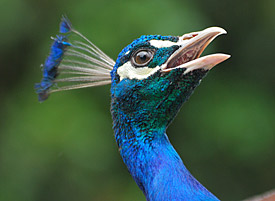Press release from July 19th, 2007
Mothers invest more in reproduction when their mates are attractive
Paris/Leipzig. Animals in nature can behave according to basic rules of economics, such as investing in agreement with their expected payoff. A French team of behavioural ecologists demonstrated that, in the Peafowl, females paired with attractive males invested more resources in their eggs than females paired with unattractive males. They laid larger eggs and deposited more testosterone in egg yolk, potentially offering a better prospective to their offspring.

Peafowl females paired with attractive males invested more resources in their eggs than females paired with unattractive males.
Source: Dr. Dirk Schmeller/UFZ

Eyespot densities of peacocks are known as a trait to be attractive to females.
Source: Dr. Dirk Schmeller/UFZ
Adeline Loyau, Michel Saint Jalme, Robert Mauget, and Gabriele Sorci of the National Museum of Natural History and the Laboratory of Evolutive Parasitology, Paris, investigated maternal investment in the peafowl (Pavo cristatus). The initial idea for the experiment derived from Marion Petrie’s study published in 1994 showing that peahens mated to peacocks with more ornamented tails produced offspring that grew faster and had a better survival. At that time, such results were explained by the transmission of “good genes” from the attractive fathers to the offspring. However, “we now know that the energy spend by the mother in egg production, and especially the allocation of resources such as proteins, lipids, antibodies or testosterone in the eggs can significantly improve offspring growth and survival prospects” says Adeline Loyau, a postdoctoral researcher at the Helmholtz Centre of Environmental Research (UFZ) in Leipzig, who conducted this study during her PhD in France.
Adeline Loyau and colleagues mated peahens with peacocks with various eyespot densities, a trait known to be attractive to females, and collected the produced eggs. After determination of the egg volume, the eggs were artificially incubated. They assessed the testosterone level of two fertilized eggs per male and all the unfertilized ones. They found that “females paired with males with higher eyespot density spent more energy in the reproduction. They laid bigger eggs containing more testosterone. Doing so, these females potentially prepare a better future for their offspring as in other species, such eggs are known to increase egg hatching success, chick growth, mobility and survival, and even future social rank and attractiveness.”
If the allocation of resources in their eggs is that beneficial for the offspring, one can wonder why the mothers do not invest the maximum in each of their eggs. “The total energy a female can spend in her life is limited”, explains Adeline Loyau, “so she has to save it until she can expect a good payoff from her expense. In a previous experiment, we demonstrated that attractive males are also males in better health and with a better immune system. Therefore, when a female mates with an attractive male, she can expect offspring of good quality. For example, more attractive offspring, and offspring that will better survive.”
“Our results suggest that the peahens choose to put all their eggs in one basket by favouring chicks with good paternal genes through maternal investment” concludes Adeline Loyau.
Publication:
Adeline Loyau, Michel Saint Jalme, Robert Mauget and Gabriele Sorci:
„Male sexual attractiveness affects the investment of maternal resources into the eggs in peafowl (Pavo cristatus)”
Behavioral Ecology and Sociobiology, Volume 61, Number 7 / 2007, 1043-1052
DOI 10.1007/s00265-006-0337-3
www.springerlink.com/content/u076231t7642
Links:
- http://www.adeline-loyau.net
- http://en.wikipedia.org/wiki/Peacock
- http://parasito-evolutive.snv.jussieu.fr
- http://www.mnhn.fr
More information:
Helmholtz Centre for Environmental Research - UFZ
Dr. Adeline Loyau, Conservation research
phone +49-341-235-3282
al@adeline-loyau.net
www.ufz.de/index.php?en=14594
Helmholtz Centre for Environmental Research - UFZ
Press office
Tilo Arnhold / Doris Böhme
phone +49 341 235 2278
presse@ufz.de
The Helmholtz Centre for Environmental Research – UFZ was established in 1991 and has about 800 employees in Leipzig, Halle/S. and
Magdeburg. They study the complex interactions between humans and the environment in cultivated and damaged landscapes. The scientists
develop concepts and processes to help secure the natural foundations of human life for future generations.
The Helmholtz Association contributes to solving major challenges facing society, science and the economy with top scientific achievements
in six research areas: Energy, Earth and Environment, Health, Key Technologies, Structure of Matter, Transport and Space.
With 25,700 employees in 15 research centres and an annual budget of approximately 2.3 billion euro, the Helmholtz Association is
Germany's largest scientific organisation. Its work follows in the tradition of the great natural scientist Hermann von
Helmholtz (1821-1894).
